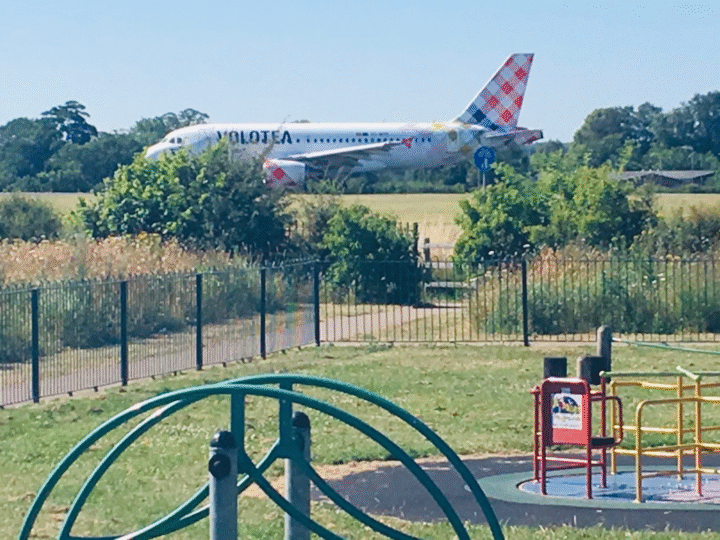30th October, 2025
The serious “physical and mental distress” of living near an airport with ineffective recourse: a case study
Despite planning restrictions intended to limit disruptive night flights, multiple exemptions and lack of meaningful oversight have left some residents in the Southend area exposed to sleepless nights and little recourse.
A resident based in Southend recently wrote in to tell us about “excessive” noise associated with his local airport. The noise occurs not just in the daytime but frequently during the night, causing serious “physical and mental distress”. He told us that there had always been an issue with aircraft noise pollution, but that it had intensified during the pandemic when cargo operations at the airport significantly increased: “Serious night flight noise and frequency increases commenced on the 22nd October 2019 with the introduction of Amazon cargo night flights.” Flights like these became more common during the pandemic as the reduction in passenger flights reduced bellyhold freight capacity, but the problem has continued into 2025.
As the resident points out, the airport is located “in the middle of a dense housing estate” with some people living “within 200m of the runway centreline”. The housing estate was gradually built around what was originally a small aerodrome that was leased by a local authority. Though popular, the aerodrome’s operations were restricted by the length of the runway.


In 2010, with the lease now in private hands, the runway was extended, subject to a Section 106 planning agreement that was meant to restrict night flight operations. According to the resident, the airport argues that there are now fewer night flights than prior to the planning agreement, but the resident challenges this. “Night flights have actually increased” he says, “and continue to be encouraged and supported by [the local authority]”.

The airport, in common with many others, operates a Quota Count (QC) system which is based on the noise classification of aircraft and the number of permitted aircraft movements of specified aircraft within a time period. The 2010 planning agreement stipulates that the Night Quota Period is between the hours of 11pm and 6.30am. During this period, “no aircraft with a Quota Count of more than one (QC1) nor any helicopter shall be permitted to take off from, and/or land at, the Airport”. However, there are several exclusions. For example, the rule doesn’t include aircraft that were scheduled to take off or land before the 11pm threshold but were delayed by poor weather conditions, or industrial action or air traffic control issues. If that’s the case, the airline can be granted a dispensation (a system that is routinely exploited by operators at many UK airports). In addition, aircraft with lower noise classifications (below 84 EPNdB, the threshold for QC0.25) are also exceptions to the rule and this includes many private jets. These aircraft may be quieter relative to larger jets, but they are noisy enough to disturb sleep at night.
On 31st March 2025, the private jet centre next to the airport extended its operating hours. It now operates flights between 6:00am and 1:30am all year year-round, whereas the 2010 planning agreement stipulates the nominal operating hours of 11pm to 6.30am. The airport boasts that this “offers a seamless experience for private jet passengers and crew” and that it’s “ideal for early morning transatlantic arrivals or late night departures for pop stars or sports teams.” This is great for VIP travellers, but it’s less ideal for local residents who just need to get some sleep. One night in May 2025, the resident reports that several night flights occurred between 23:16 and 05:51. He has calculated that, “the possible maximum uninterrupted sleep during that night was 3 hours, 37 minutes”, making it difficult to achieve the number of sleep hours recommended by the NHS (between 8 and 9 hours for adults and more for children).
Potential routes to assistance have proved to be dead ends for the resident. He has tried to resolve the issue by complaining to the airport and raising it with local authority representatives, getting nowhere. He also contacted the airport’s Consultative Committee “asking for their understanding and support” and attempted to engage with the airport’s Community Noise Forum, but reports that both are dominated by airport management. In particular, he found the Community Noise Forum to be “restrictive, non-inclusive and not fit for purpose”. Previous Members of Parliament for his area supported constituents in their call for a ban on night flights at the airport. However the current Labour MP has been unwilling to further this campaign. Meanwhile, the resident tells us, the airport – which claims to be a “good neighbour” – acts with “impunity”. This is, regrettably, a situation with which AEF is very familiar.
Further reading
AEF’s Airport-related planning guide
AEF’s aircraft noise guide
GALBA’s measuring aircraft noise guide
